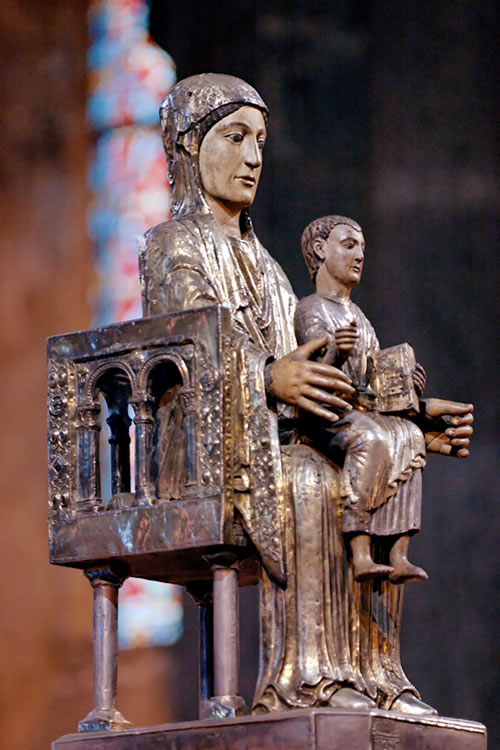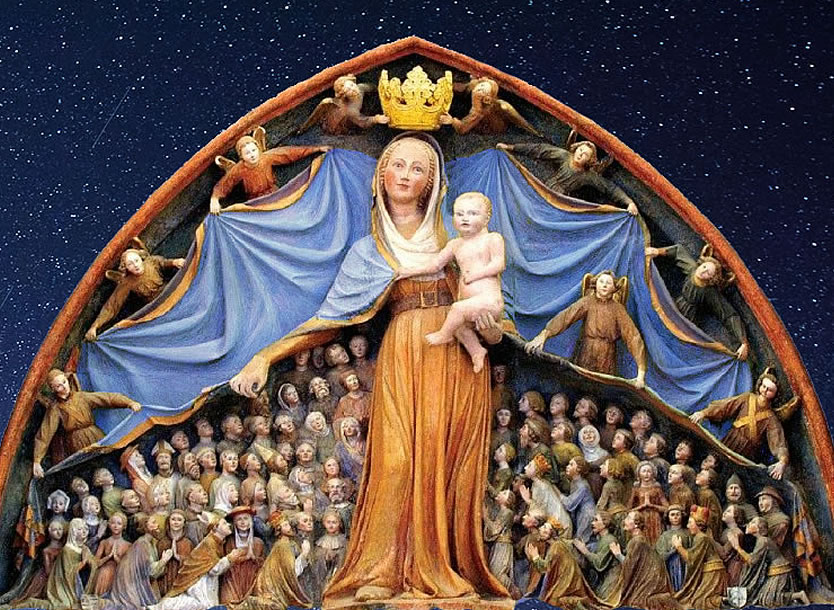If you are Catholic and you pray the Litany of the Blessed Virgin Mary, there is a 99.99% chance that, like the rest of us, you are mystified and curious about some of her titles. For example, how is she a Mystical Rose, or a Tower of David, or a Tower of Ivory, or a House of Gold? The answers are remarkable and they are all in the book A Sky Full of Stars.
We are meant to imitate the virtues of Our Lady as we invoke her titles, but we miss this opportunity if we don’t know what they mean. Go deep into each title and know Mary and fall in love with her all over again.
THE BOOK




Understand each of Our Lady's titles in the Litany
If you've been praying the Litany of the Blessed Virgin Mary (also known as the Litany of Loreto) you must have wondered what some of the titles mean.
The book A Sky Full of Stars explains each title thoroughly by invoking Scripture, Tradition, typology, and devotional writings. It is written so that you will understand it even if you are new to the faith.
By shedding light on each title, you will get to know Our Lady just a little bit more... you will fall in love with her all over again.
This video provides a little clue on how the book got its title.
READ THE WAY YOU WANT

| Paperback | ||
|---|---|---|
| ISBN 13 | 979 836 83 9795 5 | |
| ASIN | B0BQ9B2KRZ | |
| Publisher | Kindlings Press Second Edition |
|
| Publication Date | December 9, 2022 | |
| Language | English (American) | |
| Size | 6" x 9" | |
| Pages | 225 cream | |
| Cover | Full color, matte-finished | |
| BUY ON AMAZON | ||

| Hardbound | ||
|---|---|---|
| ISBN 13 | 979 837 07 8488 0 | |
| ASIN | B0BQTWVWHL | |
| Publisher | Kindlings Press Second Edition |
|
| Publication Date | December 9, 2022 | |
| Language | English (American) | |
| Size | 6" x 9" | |
| Pages | 225 cream | |
| Cover | Full color, matte-finished | |
| BUY ON AMAZON | ||

| Kindle Ebook by Amazon | |
|---|---|
| File Size | 1161 KB |
| ASIN | B0BQWBN3PB |
| Publisher | Kindlings Press Second Edition |
| Publication Date | March 6, 2020 |
| Language | English (American) |
| Print Length | 234 pages |
| Text-to-Speech | Enabled |
| X-ray | Not Enabled |
| Word Wise | Enabled |
| Enhanced Typesetting | Enabled |
| Sticky Notes | On Kindle Scribe |
|
Download the free Kindle App and start reading today. |
|
| BUY ON AMAZON | |
Now an AUDIO BOOK you can listen to!
Listen as you drive, workout, or bask under the sun.Excerpts
Preface
When I was a child, our family said the rosary together and I thought the time spent praying it was already too long. So when my mother introduced the litany that is said after the mysteries, the more I dreaded the rosary because it took more time.
Of course, that is no longer my sentiment today. I would like to think that the way I pray the rosary has changed for the better over the years. But some of Our Lady’s titles in the litany continued to trouble me because I didn’t know what they meant. These are titles like “Tower of David”, “Gate of Heaven,” and “Morning Star” to name a few. No one told me what they meant, so it felt a little bit empty and odd saying them without understanding them. It was as if I were just parroting the words.
To remedy this, I looked up the different meanings of the titles over the years. They were mostly pious expressions, and while there is nothing wrong with that, they did not really explain the titles. The internet came to the rescue when it pointed me to a book, written in 1957 by Fr. Lawrence G. Lovasik, entitled Our Lady in Catholic Life. It is a prayer book where I found out that the different titles of our Lady were remembered on each Saturday. More importantly, Fr. Lovasik’s introduction to the titles captured the background and meaning of most of them. The book is no longer in print and can be very difficult to find so I was thrilled to find a second-hand copy through book dealers.
The search led me to Church documents, encyclicals, as well as commentaries on some of Our Lady’s titles by St. Alphonsus Liguori and Blessed John Henry Newman. One of the revelations of this search is that some titles of Our Lady explode with meaning when attached to their contexts in Old Testament episodes, culture, and temple worship. Early Christians and the Church Fathers made these typological connections early on. They saw that people, objects, and events in the Old Testament were types that foreshadowed a fulfillment in the New Testament, which are called anti-types. We can appreciate these in books like the Biblia Pauperum (The Poor Man’s Bible) and Speculum Humanae Salvationis (The Mirror of Salvation), which I heavily relied on to make sense of some titles in the Litany. These books are collections of woodblock prints that put Old Testament types side-by-side with their New Testament anti-types. The juxtaposed pictures were a way to instruct “poor men and women” who couldn’t read. Through prints like this, it is remarkable to see Mary foreshadowed; and it naturally excites me to share them with you.
I restrained from including doctrine for as much as I could, but it was just impossible to explain some of Our Lady’s titles without so doing. In the end, the finished work is a mixture of Marian devotion, Catholic doctrine, and Old Testament typology.
Introduction
This book will examine and incorporate the older meanings of the titles to understand what it is the Church was ascribing to Mary at the time of the writing. The Litany was not originally in English but in Latin. It also isn’t known when the Litany was translated into English, but a translation must have been done after its approval so it could be circulated to the English-speaking world among others.
The words of some of the English titles in the Litany have lost their meaning as the usage changed through time. What might have meant something in the 16th century might no longer apply today. The word “amiable,” for example, means “friendly” as we use it today. Its use has declined since the 1800’s and originally meant “loveable.” When we apply this to Mater Amabilis, for example, it makes more sense rendered as “Mother Most Loveable” as compared to “Mother Most Friendly.’
Another word that fails to translate the correct meaning of the Latin is Mater Admirabilis (Mother Most Admirable.) Whereas admirable means “delightful” in today's vernacular, the outdated meaning of admirable meant “wonderful.” In fact, the Dillingen copy used “mirabilis” instead of “admirabilis” to indicate someone who possessed remarkable properties.
What the Litany Does
We fall in love with Our Lady. We learn about Mary through her titles because they point to the qualities that we revere in her. By prayerfully reflecting on these titles, we get a better appreciation of what we believe of Mary. As a result, we would like to know her more intimately through prayer and meditation of the mysteries of the rosary.
We give joy to Mary. For Catholics, Mary is our Queen, our Mother, and our intercessor; but far more basic than that, she is a woman – and what woman (or man) does not like to hear the good things about her? The titles of the litany highlight her different attributes. So, instead of just saying “Mary, pray for us” several times, we use titles that point out her exemplary qualities. Just like a bride is thrilled when her husband calls her “dear, sweetheart, or honey,” Our Blessed Mother is elated when we call her with our sweet-nothings too.
We honor Mary and delight Jesus. Since Jesus gave Mary to us as our mother, we affectionately observe the fourth commandment by honoring her through her titles. Several personal revelations of Jesus to saints record him asking them to honor Mary. To Saint Margaret of Cortona, Jesus said, “Honor my mother, of whose beauty and greatness neither the world nor Scripture has spoken fully.” To Saint Gertrude, he said, “I will repay you [for the honor]… you have shown my most sweet mother.” To Saint Bridgette of Sweden, he also said, “Honor my mother as your Lady!” These are just a few, and it wouldn’t be difficult to conclude that Christ delights in the honor we give his mother – his greatest creation.
We get to know Christ. As with most of Mary’s titles and dogmas, they are not for her benefit, but to shine a light on the identity of Christ and the Paschal Mystery of our salvation of which they are both an integral part of. Mary is the “preeminent member of the Church,” as the Catechism puts it because she is a perfect reflection of her son. The titles, therefore, are understood in the context of Christ, which we are then drawn to contemplate on. We are hard-wired to be attracted to the good, the beautiful, and to love. So, as we contemplate Christ, we cannot but fall deeper and deeper in love with him for God is all-good, all-beautiful, and all-loving.
Mystical Rose
The connection of saints to flowers is strong. There is a wonderful story of a Church in Mentosca d’Agesco in Austria, of a cut lily that was placed in the hand of the statue of Saint Anthony of Padua that remained fragrant and alive for almost a year – only to produce a second bloom that filled the church with its aroma.
This association with flowers even manifests itself in religious art. Saint Dominic, for example, is usually portrayed in paintings with a lily as a symbol of chastity. Saint Catherine of Siena has a lily for her emblem. Saint Agnes and St. Sebastian are commonly depicted with a palm branch. Saint Barnabas is associated with an olive branch; and St. Ursicinus, a fleur-de-lis.
Saints also emit what is called an odor of sanctity. It is alternately used figuratively or literally. In the figurative sense, the odor of sanctity pertains to the “fragrance” of a soul that is in a state of grace. In the literal sense, some saints actually emitted a scent. For example, the blood from Saint Pio’s stigmata smelled of flowers. Saint Teresa of Avila and Saint Maravillas of Jesus emitted a strong flowery bouquet after their death. Saint Therese of Lisieux – also called the Little Flower – produced a strong fragrant aroma of roses after she died.
Saints, then, are like flowers because they emit a “fragrance” just like flowers do. In the Song of Songs, the husband tells her bride, “You are a private garden, my treasure, my bride…” Since the Song of Songs is an allegorical canticle expressing God’s love for his Church (which is his bride and mystical body), he is regarding it as a garden. If heaven were a garden, then saints would be “mystical flowers” in that garden.
In the Davidic Kingdom, there is what is called the Gebirah – the queen mother. Because kings after David were polygamous, it became difficult to determine who was queen. So, it is said the Israelites emulated eastern kingdoms where it is the king’s mother who is crowned queen. So, because Jesus is a king in the line of David, it is through this tradition that his mother, Mary, is the queen. That is why she is Our Queen. That is why we call her “Our Lady.”
In the botanical world, the rose is the queen of flowers. So, if saints are mystical flowers, then Mary is the mystical rose whose spiritual beauty and fragrance outclasses them all.
Mary is like a white rose in her purity. She is like a red rose stained by the blood of Christ as she kept him company under the cross. She is also like a gold rose as she rejoices in the bliss and glory of her son’s Resurrection. The green leaves of the rose symbolize hope – as she is the fulfillment of hope for which we aspire.
Mother of Mercy
Sometime in the thirteenth century, a Cistercian monk had a heavenly vision of Mary surrounded by some monks. He felt sad because he didn’t see any monks of his order. So, he asked Our Lady why his order was not with her considering their great devotion to her. She answered: “I love my Cistercians so much that I keep them covered with my arms.” She opened her mantle and he saw under it many Cistercian monks. This story became so popular in Europe that artists drew her mantle wider and wider so that more and more people could fit under it.
Eventually, the only way to fit the entire world under her mantle of protection was to make the sky her mantle. This is why until today her mantle is usually blue, and usually decorated with stars. Churches usually associated with our lady have ceilings painted as a sky full of stars. The Notre Dame Basilica in Ottawa, and St. Mary’s Basilica in Krakow are good examples of this. Even churches or structures that do not bear Our Lady’s name like the Duomo of Siena, the Sainte-Chapelle in Paris, and the Baldacchino in St. John Lateran Basilica also have blue ceilings with stars. It should not come as a surprise that before Michelangelo painted the ceiling of the Sistine Chapel, it was blue bedecked with golden stars.
Sometimes we sinners need a place to heal – a place to start anew. Mary is a reflection of God’s unconditional love so she opens her mantle not just to the pious, not just to the saints, but to all of us sinners. There should be no reason, then, why we should have any anxiety about going to her.
Because we can heal under her loving care, she is like a “hospital for sinners” as St. Ephraem rightly calls her. She is also like those ancient Judean cities where criminals flee for protection because the city exempted offenses from being punished. There they could muse on the wrong they have done and how they can begin a new and righteous life. We are reminded that Mary is like that place when we hear St. Alphonsus Liguori quote, “Flee, Adam and Eve, and all you their children, who have outraged God! Flee, and take refuge in the bosom of this good mother. Don’t you know that she is our only city of refuge?”
When invoking this title, consider: we can go to Mary when we are troubled about anything.
Queen of Martyrs
Saint Bernard said that the Passion of Jesus began with his birth but with Mary, it began during the Annunciation. When Mary gave her fiat, she gave up the simple life she wanted to live. Right away difficulties arose: dealing with Joseph regarding her miraculous conception, riding a donkey all the way to Bethlehem while being nine-months pregnant, giving birth in a stable. When she brought the child Jesus to the temple, it became clear that difficulties would be part of her life when the prophet Simeon told her “your own soul a sword shall pierce.”
Those that study Mary’s life count seven swords or sorrows starting with that of Simeon’s prophecy. The next sorrow is when she had to escape with Joseph to Egypt, fleeing from the assassins of King Herod. The third is when she lost Jesus in the Temple – one can only imagine her worry as a mother. The fourth is when she met Jesus as he carried the cross. Fifth is his crucifixion and death. As if his death were not enough, a soldier had to pierce his side – which is the sixth sorrow. Finally, the last sorrow is the burial of Christ – the definite moment when she had to physically detach herself from the person she dearly loved.
In art, we see martyrs depicted with the instruments of torture used on them. Saint Andrew with a cross, St. Laurence with a gridiron, Saint James the Lesser with a club, Saint Simon the Zealot with a saw, Saint Bartholomew with his flayed skin, Saint Catherine with a spiked wheel, and Saint Sebastian with arrows, to name a few.
The Pieta of Michelangelo is a sculpture of the lifeless Christ on Mary’s lap. It is an image of sorrow that we can see Mary as Queen of Martyrs. Saint Alphonsus Liguori quoted Diez who said, “Martyrs are represented with the instruments of their suffering… Mary is represented with her dead son in her arms; for Jesus himself, and he alone, was the instrument of her martyrdom, by reason of the love she bore for him.” One must look at the opened hand of Mary in the Pieta for it presents the dead Christ to the viewer. Her hand quietly gestures, “Look, at what my son has done for you.” It also proclaims, “This is what I have suffered.”
When invoking this title, consider: the death of Christ made Mary suffer more than the ordeal of any martyr.
HIGHLIGHTS
WHAT PEOPLE ARE SAYING
THE AUTHOR

Joby finished his theology courses on doctrine, scripture, liturgy, and catechism from the satellite program of the University of Notre Dame. He is a contributing writer at theCatholicTalks.com, and catholic365.com where some of his articles have been translated into different languages for different websites around the world. He is passionate about suffrage for the souls in purgatory and maintains IndulgenceCooperative.org
He teaches multimedia arts at a prominent arts and design school where he engages students in conversations about religion, spirituality, pop-culture, and food.
Feel free to contact him if you want a talk in your organization.

















